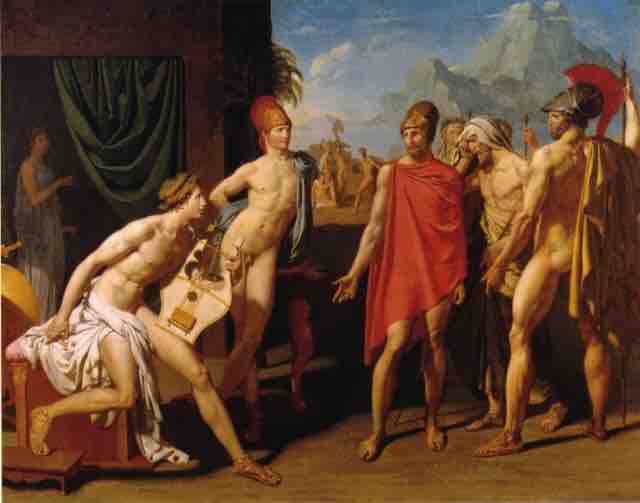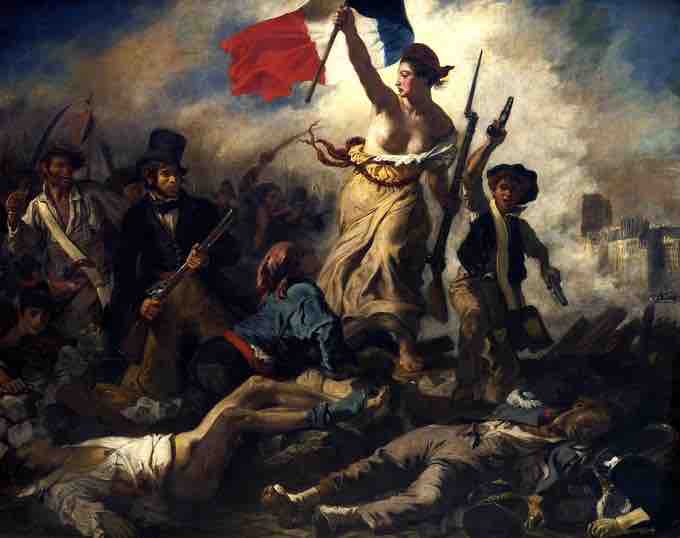Romanticism
While the arrival of Romanticism in French art was delayed by the hold of Neoclassicism on the academies, it became increasingly popular during the Napoleonic period. Its initial form was the history paintings which acted as propaganda for the new regime. The key generation of French Romantics born between 1795–1805, in the words of Alfred de Vigny, had been "conceived between battles, attended school to the rolling of drums". The French Revolution (1789–1799) followed by the Napoleonic Wars until 1815, meant that war, and the attending political and social turmoil that went along with them, served as the background for Romanticism.
History Painting
Since the Renaissance, history painting was considered among the highest and most difficult forms of art. History painting is defined by its subject matter rather than artistic style. History paintings usually depict a moment in a narrative story rather than a specific and static subject. In the Romantic period, history painting was extremely popular and increasingly came to refer to the depiction of historical scenes, rather than those from religion or mythology.
French Romanticism
This generation of the French school developed personal Romantic styles while still concentrating on history painting with a political message. Théodore Géricault's The Raft of the Medusa of 1821 remains the greatest achievement of the Romantic history painting, which in its day had a powerful anti-government message.
Jean Louis Theodore Gericault, The Raft of the Medusa, 1818-21
This painting is regarded as one of the greatest Romantic era paintings.
Ingres
Profoundly respectful of the past, Ingres assumed the role of a guardian of academic orthodoxy against the ascendant Romantic style represented by his nemesis Eugène Delacroix. He described himself as a "conservator of good doctrine, and not an innovator. " Nevertheless, modern opinion has tended to regard Ingres and the other Neoclassicists of his era as embodying the Romantic spirit of his time, while his expressive distortions of form and space make him an important precursor of modern art.

The Envoys of Agamemnon, by Ingres, 1801
Ingres, though firmly committed to Neoclassical values, is seen as expressing the Romantic spirit of the times.
Delacroix
Eugène Delacroix (1798–1863) had great success at the Salon with works like "The Barque of Dante (1822)," "The Massacre at Chios" (1824) and "Death of Sardanapalus" (1827). Delacroix's "Liberty Leading the People"(1830) remains, with the Medusa, one of the best known works of French Romantic painting. Both of these works reflected current events and appealed to public sentiment .

Liberty Leading the People, by Delacroix, 1830
The history paintings of Eugene Delacroix epitomized the Romantic period.
Goya
Spanish painter Francisco Goya is today generally regarded as the greatest painter of the Romantic period . However, in many ways he remained wedded to the classicism and realism of his training. However, more than any other artist of the period, Goya exemplified the Romantic expression of the artist's feelings and his personal imaginative world. He also shared with many of the Romantic painters a more free handling of paint, emphasized in the new prominence of the brushstroke and impasto, which tended to be repressed in neoclassicism under a self-effacing finish. Goya's work is renowned for its expressive line, color, and brushwork as well as its distinct subversive commentary.

The Milkmaid of Bordeaux, by Goya, ca. 1825-1827
Though he worked in a variety of styles, Goya is remembered as perhaps the greatest painter of the Romantic period.
German Romanticism
Compared to English Romanticism, German Romanticism developed relatively late, and, in the early years, coincided with Weimar Classicism (1772–1805). In contrast to the seriousness of English Romanticism, the German variety of Romanticism notably valued wit, humour, and beauty.
The early German romantics strove to create a new synthesis of art, philosophy, and science, largely by viewing the Middle Ages as a simpler period of integrated culture, however, the German romantics became aware of the tenuousness of the cultural unity they sought. Late-stage German Romanticism emphasized the tension between the daily world and the irrational and supernatural projections of creative genius. Key painters in the German Romantic tradition include Joseph Anton Koch, Adrian Ludwig Richter, Otto Reinhold Jacobi, Philipp Otto Runge among others.
The Hulsenbeck Children, Phillip Otto Runge, oil on canvas
Runge was a well known German Romantic painter.